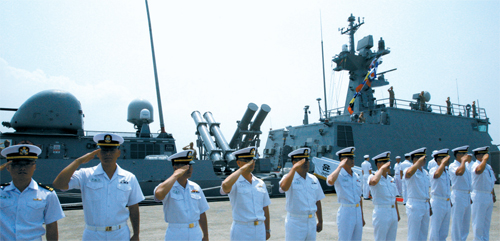As tensions rise, Navy celebrates victory

Sailors of the Yoon Young-ha PKG (Patrol Killer, Guided-Missile) class ship salute yesterday to commemorate the 10th anniversary of the South Korean Navy’s successful battle on the Yellow Sea against North Korea in 1999. The boat is named after Lieutenant Commander Yoon, who was killed with five sailors during the second clash with North Korean naval forces in 2002. By Kim Kyung-bin
Commemorating the 10th anniversary of its lopsided battle on the Yellow Sea against North Korea, the South Korean Navy yesterday vowed to protect the South Korean waters against any North Korean provocations as tensions increased on the peninsula.
Also yesterday, a former commander during that incident charged that the navy’s hands had been tied by official government policy.
The South Korean Navy marked the 10th anniversary of the First Yeonpyeong Naval Battle at the Navy’s Second Fleet Command in Pyeongtaek, Gyeonggi. On June 15, 1999, North Korea fired shots toward the South Korean side at the Northern Limit Line, the western sea border. The South turned back the North in just 14 minutes, killing at least 30 North Korean soldiers, injuring about 70 others, and destroying 10 vessels.
Nine South Koreans were wounded but there were no deaths. The South’s Navy ships only suffered minor damage.
The annual ceremony, attended by commanders and veterans who fought in the battle, was hosted for the first time by the Navy, rather than the Second Fleet Command.
The command’s Lieutenant Commander Kwon Young-il pledged that if forced, the South could take decisive action against the North. “Where our enemy provokes is where we will sink them,” Kwon said.
Addressing the ceremony, General Jung Ok-geun, the Navy chief of staff, spoke of the South Korean Navy’s “overwhelming victory” a decade ago in the first military conflict between the Koreas since the Korean War (1950-53).
“It was the great triumph, a combination of our Navy’s sophisticated weapons system, mental toughness and perfect operations,” Jung said.
But the general cautioned that there could be further tests ahead.
“Based on our two naval clashes [the Second Yeonpyeong Battle occurred in 2002], we have to bear in mind that a third such battle could take place at any moment,” Jung said. “In any situation, I ask you to fight our enemy and inherit the winning ways from 10 years ago.”
And that victory wasn’t as easy as it appeared, said Park Jeong-seong, the commander of the Second Fleet at the Yeonpyeong battle.
Park, a retired rear admiral, said that former President Kim Dae-jung “tied our hands” with restrictive orders. “President Kim asked us never to strike first, never to leave the NLL, never to escalate the situation and to act wisely in any situation,” Park said. “We’d been expecting the North Korean action for six months, but we weren’t really free to exercise our right to defend ourselves.”
Park said South Korean vessels came within striking distance of North Korea and still couldn’t attack first. This stirred some debate within the Navy after the battle.
“I argued that our vessels had to be moved away from the NLL to safe waters after the clash,” Park said. “But some superiors ordered us to redeploy near the sea border.”
Park said as a field commander, he was frustrated with the presidential order to act wisely, which he said was “vague and ambiguous.”
Park also revealed that despite the presidential order, the Blue House, the Joint Chiefs of Staff and the Navy essentially told the commanders to act at their own discretion. Only the defense minister at the time, Cho Sung-tae, called Park each night to remind him of the orders.
Despite his actions, Park couldn’t move up the ranks and retired in 2004. “Our soldiers risked their lives against the North Korean provocation to win the battle,” Park said. “But the Sunshine Policy [Kim’s engagement policy on North Korea] overshadowed their feat.”
In May, following its second nuclear test, North Korea threatened to take military action against South Korean vessels in the Yellow Sea. That warning came in response to South Korea’s full participation in the Proliferation Security Initiative, a U.S.-led effort to curb shipments of weapons of mass destruction and related materials.
Since then, the combined forces of South Korea and the United States raised their alert level against North Korea to its highest in three years and announced they would intensify their intelligence-collecting and reconnaissance efforts.
In late May, Chinese fishing boats pulled away from the Yellow Sea as suspicions grew that North Korea ordered them to do so to prepare for military action there.
Then on June 5, a North Korean patrol boat crossed the NLL and turned back after nearly an hour following two warning messages by the South Korean Navy.
By Yoo Jee-ho, Kim Min-seok [jeeho@joongang.co.kr]










with the Korea JoongAng Daily
To write comments, please log in to one of the accounts.
Standards Board Policy (0/250자)